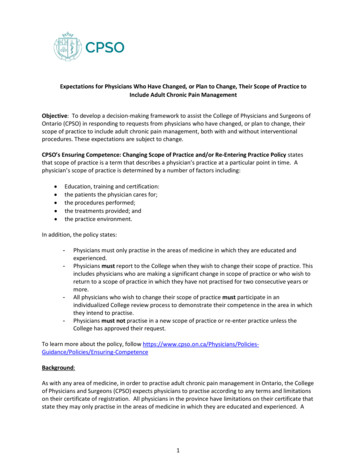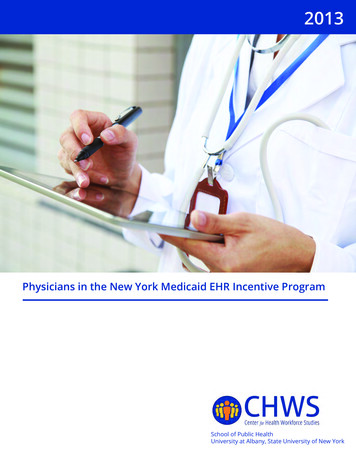
Transcription
Expectations for Physicians Who Have Changed, or Plan to Change, Their Scope of Practice toInclude Adult Chronic Pain ManagementObjective: To develop a decision-making framework to assist the College of Physicians and Surgeons ofOntario (CPSO) in responding to requests from physicians who have changed, or plan to change, theirscope of practice to include adult chronic pain management, both with and without interventionalprocedures. These expectations are subject to change.CPSO’s Ensuring Competence: Changing Scope of Practice and/or Re-Entering Practice Policy statesthat scope of practice is a term that describes a physician’s practice at a particular point in time. Aphysician’s scope of practice is determined by a number of factors including: Education, training and certification:the patients the physician cares for;the procedures performed;the treatments provided; andthe practice environment.In addition, the policy states:--Physicians must only practise in the areas of medicine in which they are educated andexperienced.Physicians must report to the College when they wish to change their scope of practice. Thisincludes physicians who are making a significant change in scope of practice or who wish toreturn to a scope of practice in which they have not practised for two consecutive years ormore.All physicians who wish to change their scope of practice must participate in anindividualized College review process to demonstrate their competence in the area in whichthey intend to practise.Physicians must not practise in a new scope of practice or re-enter practice unless theCollege has approved their request.To learn more about the policy, follow /Policies/Ensuring-CompetenceBackground:As with any area of medicine, in order to practise adult chronic pain management in Ontario, the Collegeof Physicians and Surgeons (CPSO) expects physicians to practise according to any terms and limitationson their certificate of registration. All physicians in the province have limitations on their certificate thatstate they may only practise in the areas of medicine in which they are educated and experienced. A1
physician’s competence within a scope of practice is determined by their education, training andexperience within that scope.Regardless of specialty background, a physician must ensure that s/he has the appropriate education,training, and experience for the specific procedures that s/he plans to include in his or her practice.In determining the appropriateness of an individual physician’s request to change their scope of practicethe CPSO relies primarily upon certification processes from the Royal College of Physicians and Surgeonsof Canada (RCPSC) in order to determine which physicians can be designated as specialists in a givenfield of practice.The purpose of this document is to clarify the CPSO’s expectations for physicians intending to changetheir scope of practice to include adult chronic pain management. In this type of practice, as well as inothers, physicians must ensure they are meeting the standard of practice, which includes conducting arisk/benefit analysis to assess the appropriateness of performing any given procedure.It must be emphasized that if a physician plans to practise adult chronic pain management in an Out-ofHospital Premises (OHP) they must meet the qualifications set out in the Out-of-Hospital PremisesInspection Program Standards and also complete all CPSO requirements for Changing Scope of Practice.While the change in scope of practice process generally involves training, supervision and assessment,all of these components may not apply in every case. As with all requests for change in scope issues, inarriving at a decision, the CPSO will review each physician’s individual circumstances.DEFINITION“Pain Medicine is a medical subspecialty concerned with the prevention, evaluation, diagnosis,treatment, and rehabilitation of patients with acute and chronic pain associated with cancer andnon-cancer diagnoses.” – Royal College of Physicians and Surgeons of CanadaThe purpose of the definition is to provide guidance to physicians about how pain medicine is defined sothat physicians who intend to practise in adult chronic pain management understand when they need tocontact the College to report a change in scope of practice. In addition, this document will deal withpain medicine procedures that fall into the following categories:(i)(ii)(iii)procedures for analgesia without sedation, divided into:a. those that are peripheralb. those that may include neuraxial or deep structures, andthose that benefit from or require imagingthose that may require sedationPhysicians who practise in adult chronic pain management are required to fulfill the core competenciesset out in the “Expectations of General Knowledge, Skills and Judgment for Adult Chronic PainManagement” and, if performing procedures, the “Expectations of Procedural-Specific Knowledge, Skillsand Judgment for IPM”, set out below. For the purpose of this document, the procedures listed inAppendix 1 entitled “List of Interventional Pain Procedures” will be considered as “interventional painmanagement” procedures by the College.Physicians who intend to include adult chronic pain management as part of their scope of practice andwho do not have the training and/or experience to practise competently in the new area of practice are2
required to comply with the College’s Ensuring Competence: Changing Scope of Practice and/or ReEntering Practice policy.Requirements for Adult Chronic Pain ManagementPhysicians who have completed a RCPSC residency program, for example in anesthesia, physicalmedicine, etc., may have recent relevant training in adult chronic pain management, includinginterventional procedures. Regardless, the College needs to consider the physician’s specialtybackground, prior training and/or experience, as well as his or her intended practise and procedureswhen determining overall needs. Moreover, physicians who have received formal training in adultchronic pain management but have not practised in this field for more than two years need to apply fora change in scope of practice, despite their related training/specialty background, to determine if thereare any additional requirements under the Ensuring Competency: Changing Scope of Practice and/or Reentering Practice policy.Physicians applying for a change in scope of practice to include adult chronic pain management mustsatisfy the requirements listed in one of two different pathways:Pathway 1 - Academic Training Pathwaya) Successfully complete an accredited training program at a Canadian or an ACGME 1 recognizedMedical School Department or Division that must be structured such that it includes:i.ii.iii.iv.A designated program directorStandard, written training objectivesA formal, regular evaluation processA mechanism to report the Program’s assessment of the individual’s competence at theend of the program.v. All components contained within this document entitled “A) Expectations of GeneralKnowledge, Skills and Judgment for Adult Chronic Pain Management” and B) Acquisitionof Procedural-Specific Knowledge, Skills, and Judgment in IPM”.vi. A mechanism to document all training experiences including the number and types ofinterventional pain procedures performed. 2 At a minimum, it is recommended thattrainees complete a minimum of 12 months of overall training gaining skills as defined inSections A and B of this document.b) The program must be completed in less than 36 months and must have been completed withintwo years prior to application to change scope of practice.Accreditation Council for Graduate Medical Education (ACGME) is responsible for the accreditation of post-MD medicaltraining programs within the United States. Accreditation is accomplished through a peer review process and is based uponestablished standards and guidelines.2 Each situation would be assessed on an individual basis in order to assure competency has been achieved in procedure(s) thatthe physician intends to add to his or her practice. In addition, techniques involving the use of fluoroscopy or ultrasoundimaging require specialized training that should be sponsored by an accredited organization.13
Pathway 2 – Significant Practice Experience in Adult Chronic Pain ManagementThis would essentially include physicians who are coming to Ontario from another jurisdiction wherethey have demonstrated significant experience that is satisfactory to the College, or who are returningto the practice of adult chronic pain management after an absence of more than two years. Additionally,physicians with significant practice experience in a field closely related to pain medicine and whosecurrent practice includes comprehensive management of patients with chronic pain, may seek a changein scope of practice through this pathway, subject to College approval.Regardless of the pathway, the changing scope of practice process generally involves a needsassessment, training, supervision and assessment, though all of these components may not apply inevery case. In arriving at a decision, the College will review each physician’s individual circumstances,and will consider them in relation to the factors outlined below.Clinical Supervision and Assessment RequirementsThe need for supervision 3 (level and duration) is determined at the discretion of the College and willdepend on the physician’s intended scope of procedures, and previous training and experience. Theassessment will be multi-modal in nature, e.g. direct observation, chart review, interviewing colleagues,etc. The nature of the assessment will be determined by the physician’s proposed practice in adultchronic pain management, including scope of procedures.Once the supervision phase is complete, the physician may be required to take additional stepsincluding undergoing a College-directed assessment prior to being approved for a change in scope ofpractice. Once approved, should a physician wish to add any new high-risk procedures to his or herpractice, an application to the College will be required.Each physician’s situation will be assessed on an individual basis, and therefore, the levels and durationof supervision are discretionary. In addition, the supervisor’s feedback in the form of supervision reportswill be considered by the College when determining a change in level of supervision, and whether thephysician will require additional training.In order to ensure physicians receive consistent and comprehensive training in all aspects of adultchronic pain management by individuals with extensive experience in medical education and training,the College will no longer allow training for changing scope of practice processes to occur in Out-ofHospital Premises, unless those premises are affiliated with an academic training program and approvedby the academic Program Director. Individuals who apply to change their scope of practice to includeadult chronic pain management who require training will be directed to academic training.3Refer to the “Guidelines for College-Directed Clinical Supervision” for more information about the responsibilities andcharacteristics necessary for a Clinical Supervisor which are available here: irected-Supervision(1)4
(A) Expectations of General Knowledge, Skills, and Judgment for Adult Chronic Pain ManagementAny physician planning to practise pain medicine should be competent in: accurate bedside and laboratory assessment and diagnosis of pain conditions; evidence-based medical, physical, and interventional treatment; fluoroscopy and ultrasound techniques and imaging interpretation, if applicable, and; conducting and documenting appropriate follow-up care.In order to acquire the necessary knowledge, skills and judgment required for adult chronic painmanagement, physicians will acquire the core competencies through:1. Clinical training in a CPSO approved accredited training program where the physician willacquire competency in: Assessing and managing patients with regard to pain mechanism, co-morbidities, andfunctional impairment; Knowledge of the pathophysiology of chronic pain; Non-pharmacological rehabilitation strategies; Identifying and managing opioid misuse problems; The effective use of opioids in pain management; The effective use of non-opioid medications in pain management; Drug interactions and adverse effects; Epidemiology of pain and co-morbidity of psychological conditions, and; The use of measurement scales in pain practice.2. Competent to understand and use basic cognitive behavioural techniques in practice (ifapplicable) and being aware of the interplay between psychiatric conditions and pain conditions.3. Competent in the management of complications and preparation for handling emergencysituations which may arise in the outpatient setting of an interventional pain practice.4. Competent in:o Management of acute and chronic neck and back pain;o Management of headache;o Management of chronic soft tissue, myofascial, and fibromyalgia pain;o Management of chronic visceral pain;o Sleep disorders;o Neuropathic pain, and;o Pain in the elderly, in pregnancy and lactation (if applicable).5. Completing specific courses 4 as recommended by his/her supervisor.4For example, Canadian Pain Society-sponsored interventional pain courses, ISIS courses to provide basic knowledge andpractice for fluoroscopy and ultrasound-guided interventions, or the University of Toronto Safe Opioid Prescribing Course.5
(B) Expectations of Procedural-Specific Knowledge, Skills and Judgment for Adult Chronic PainManagementPhysicians, having gained competencies and general knowledge, skills and judgment required for thediagnosis and management of adult chronic pain are then required to have specific proceduralcompetence for each procedure that they want to perform. For any given procedure, the physicianmust:1) Demonstrate experience with all aspects of the clinical features of the procedure throughtheir approved training program. The clinical features to be learned include:a) Assessing patients in consultation for suitability, indication, and frequency for theprocedure, discussion of risks, benefits and alternatives, obtaining informed consentand routine pre-procedure assessment;b) Assessing patients with regard to the risks/benefits of using sedation, with knowledgeand experience in IV access and monitoring;c) Assessing patients in the immediate pre-procedure period, including patient positioning,identification of landmarks;d) Assisting and eventually performing the procedure, with knowledge and experience inmanaging complications;e) Management of the patient in the immediate post-procedure period, including anypost-procedure complications, and;f) Management of the patient and complications at follow-up.2) Demonstrate experience with all aspects of the clinical features of the procedure.3) Obtain Advanced Cardiac Life Support certification.4) Acquire competency in Imaging interpretation, if applicable.5) Acquire competency in fluoroscopy and ultrasound techniques, if applicable; this wouldinclude basic knowledge of radiation safety.6) Demonstrate knowledge of how to identify and manage emergency situations in IPM relatedto:a. Vasovagal Reactionb. Hypotensionc. Hypertensiond. Local anaesthetic toxicitye. High Spinalf. Pneumothoraxg. Anaphylaxish. Spinal cord ischemia/paralysis (e.g. related to transforaminal epidural steroidinjections, or celiac plexus blocks/splanchnic blocksi. Seizuresj. Airway obstruction, acute respiratory failure (including competency in basic andadvanced airway techniques such as endotracheal intubation)6
7) Demonstrate competence in the above areas through a College-directed assessment ofhis/her practice in the relevant area. The College assessment may include, but is not limitedto:a) A review of all educational outcomes and supervision reports from the entireeducational process;b) A review of patient charts in private office, or hospital, or clinic;c) Observation of physician performing procedures requested in the change of scope ofpractice application;d) Multi-source feedback including, but not limited to, interviews with significantstakeholders including all supervisors, staff including nursing, medical staff, physicianswho refer to the physician, and patients.Revised: June 20207
Appendix 1 – List of Interventional Pain ProceduresBelow is a listing of interventional procedures appropriately performed in interventional clinics. Some of these benefit from imaging guidance.Treatment may include injection of medications and/or use of radio frequency lesioning or pulsed treatment.Interventional Pain Management ProceduresRISK LEVELTYPE OF NERVE BLOCKDEFINITIONCRANIAL NERVE BLOCKS/DEEP NERVES OF THE HEAD AND NECKHIGH RISKLOW RISKTrigeminal/Ganglion BlockA block of the trigeminal ganglion (semilunar ganglion, gasserian ganglion) situated in Meckel’scavity. The block is used in the treatment of trigeminal neuralgia, cluster headaches, pain in theeye region and other head and facial pain.Sphenopalatine Ganglion BlockA block of the nasoplatine nerve(s) used for treating facial and head pain located inpterygopalatine fossa.Glossopharyngeal Nerve BlockA block of the glossopharyngeal nerve in the extracranial course for treatment of facial andhead pain.Hypoglossal Nerve BlockA block of the XII cranial nerve involving the tongue.Maxillary Nerve BlockThe nerve emerges from the skull through the round foramen. The nerve can be accessedintra-orally (medial to the posterior edge of the second maxillary molar through the greaterpalatine foramen) or extra orally above or beneath (mandibular fossa) the zygomatic arch fornerve blocks.Spinal Accessory Nerve BlockA block of the spinal accessory nerve (cranial nerve XI).Superficial branches of CN VA block of the 3 divisions of the Cranial V nerve or trigeminal nerve. This includes V1, V2 and V3distribution or ophthalmic, maxillary and mandibular nerves respectively.Mandibular Nerve BlockA block of the mandibular nerve for treatment of facial pain in the V3 distribution.Auriculotemporal Nerve BlockBlock of the nerve at the origin of the zygoma between the otic canal and temporomandibularJoint.Infraorbital Nerve BlockBlock of the nerve at the infra-orbital foramen.Mental Nerve BlockThe mental nerve is the sensory end branch of the mandibular nerve as it emerges from themental foramen. Nerve blocks can be carried out intra or extra orally.Supraorbital BlockThe supraorbital nerve passes through the supraorbital notch. The nerve block is carried outafter palpation of the supraorbital foramen.8
Interventional Pain Management ProceduresRISK LEVELTYPE OF NERVE BLOCKDEFINITIONZygomatic Temporal Nerve BlockBlock of the nerve between the orbit and the ear superior to the zygomatic arch.OccipitalOccipital nerve blocks including greater or lesser occipital nerves.NEURAXIAL BLOCKSHIGH RISKCentral neuraxial blocksincluding:Neuraxial anesthesia pertains to local anesthetics placed around the nerves of the centralnervous system, such as spinal anesthesia (also called subarachnoid anesthesia), and epiduralanesthesia. Intrathecal blocksIntrathecal Block is administration of drugs into the subarachnoid space. Spinal cord stimulationA spinal cord stimulator is a device used to exert pulsed electrical signals to the spinal cord tocontrol chronic pain. Spinal cord stimulation (SCS), in the simplest form, consists of stimulatingelectrodes, implanted in the epidural space, an electrical pulse generator, implanted in thelower abdominal area or gluteal region, conducting wires connecting the electrodes to thegenerator, and the generator remote control. SCS has notable analgesic properties and, at thepresent, is used mostly in the treatment of failed back surgery syndrome, complex regional painsyndrome and refractory pain due to ischemia.Epidural blocks Interlaminar Transforaminal CaudalEpidural steroid injection - There are three types of epidural steroid injection: interlaminar,caudal, and transforaminal epidural steroid injectionEpidural AdhesiolysisEpidural lysis of adhesions is performed by placement of a catheter/guide wire into the epiduralspace using X-ray guidance for proper placement. Once the catheter is in the proper locationwhere the scar tissue is affecting the nerve root, medications are injected into the space inorder to dissolve the scar tissue and reduce the inflammation and irritation on the nerve.Nerve root blocksSelective lumbar nerve root block in the vicinity of, but distal to the foramen.Blocks involving the facet joints:The target is the medial branch of the cervical, thoracic or lumbar dorsal rami where the nervescourse around the articular pillar (cervical) or between superior articular process (SAP) andtransverse process9
Interventional Pain Management ProceduresRISK LEVELTYPE OF NERVE BLOCK Medial branch block Peri-articular facet blocksDEFINITIONIntra articular facet block. Injection inside or around the facet joint.NEURAXIAL BLOCKS (continued)HIGH RISKParavertebral nerve blocksA paravertebral block is a block of the spinal nerve where local anesthetic is injected in theparavertebral space.Thoracic: The boundaries of thoracic paravertebral space are defined anterior-laterally by theparietal pleura; posteriorly by the superior costotransverse ligament (thoracic levels); mediallyby the vertebrae, vertebral disk, and intervertebral foramina; and superiorly and inferiorly bythe heads of the ribs. When the needle is inserted posteriorly, it has to pass through thetransverse process to get into the space.Lumbar: The boundaries are the psoas muscle anterolaterally, vertebral body/discintervertebral foramen, and pedicle medially, and transverse process posteriorly.Cervical: The cervical paravertebral space is not a discrete space as in thoracic and lumbarparavertebral space. The nerve block is a block of the cervical spinal nerve.Provocative discographyInjection of contrast to the nucleus pulposus of the intervertebral disc.KyphoplastyA form of Vertebral augmentation used to stabilize a fractured vertebra with the goal ofreducing the patient's pain caused by a compression fracture. Kyphoplasty involves a smallincision, and fluoroscopically guided balloon reduction of the fractured vertabrae, followed byinjection of vertebral cement into the affected vertebral level for stabilization of the fracturedvertebral fragments.10
Interventional Pain Management ProceduresRISK LEVELTYPE OF NERVE BLOCKDEFINITIONBiacuplastyA disc denervation procedure which involves fluoroscopic electrode placement ontointervertebral discs with the purpose of application of a radiofrequency current through thedisc. The goal is to achieve of ablation of the neurons that generate pain sensations. Theindication is for the reduction of chronic back pain caused by the intervertebral disc.PERIPHERAL NERVE BLOCKSHIGH RISKLOW RISKFemoralPeri-neural injection of the femoral nerve and the target is usually in the infra-inguinalregion.SciaticPerineural injection of the sciatic nerve.PoplitealPerineural injection of the sciatic nerve at the popliteal fossa.IntercostalPerineural injection of the intercostal nerve, principally the lateral cutaneous branch.PudendalPerineural injection of the pudendal nerve (S2-4) at the ischial spine level or Alcock canal. It canbe achieved by transgluteal, transvaginal or transperineal approach.Proximal Radial/Median/UlnarNerve block of the Proximal Radial/Median/Ulnar nerve.Suprascapular/transcapularSuprascapular nerve blocks at the notch or the suprascapular fossa.Ilioinguinal/iliohypogastricA block of the Ilioinguinal nerve and/or illiohypogastric nerve in the abdominal wallGenitofemoralA block of the Genitofemoral nerve.PLEXUS BLOCKSHIGH RISKDeep CervicalA deep cervical plexus block is of the C2-C4 spinal nerves as they emerge from the foramina oftheir respective vertebrae.11
Interventional Pain Management ProceduresRISK LEVELLOW RISKTYPE OF NERVE BLOCKDEFINITIONUpper extremity/BrachialA brachial plexus block is a block of the brachial plexus.CoeliacA coeliac plexus block is an injection of medication into or around the coeliac plexus thatsurround the aorta. A modification of the target is splanchnic nerves.Lower Extremity/LumbarA lumbar plexus block is a nerve block of this plexus.Hypogastric plexusA block of the Hypogastric plexus in the anterior aspect of lumbosacral junction.Ganglion of imparA block of the ganglion anterior to the sacrococcygeal junction.Superficial CervicalNerve plexus deep to the SCM muscle.SYMPATHETIC NERVE BLOCKSHIGH RISKStellate ganglionA block of the sympathetic ganglion formed by the fusion of inferior cervical and first thoracicganglion. It is commonly approached at the cervical sympathetic chain.Lumbar sympatheticA block of the sympathetic chain to the lower limb in the anteriolateral aspect of L2-L4.INTRAVENOUS BLOCKSHIGH RISKLocal AnaestheticBretyliumINTRAVENOUS INFUSIONSHIGH RISKLidocaineKetamineInjection of medication intravenously requiring pneumatic tourniquet and monitoring; limbexsanguinated and tourniquet inflation for 15 – 30 minutesContinuous IV infusion of ketamine and/or lidocaine for pain relief.JOINTSLOW RISKSacroiliac jointsAn injection of medication either intra or peri-articular of the joint.NEUROABLATIVE BLOCKSHIGH RISKRadiofrequency AblationIs a percutaneous therapeutic image-guided procedure in which a radiofrequency electrode isused to coagulate one or more nerves12
non-cancer diagnoses." - Royal College of Physicians and Surgeons of Canada. The purpose of the definition is to provide guidance to physicians about how pain medicine is defined so that physicians who intend to practise in adult chronic pain management understand when they need to contact the College to report a change in scope of practice.










